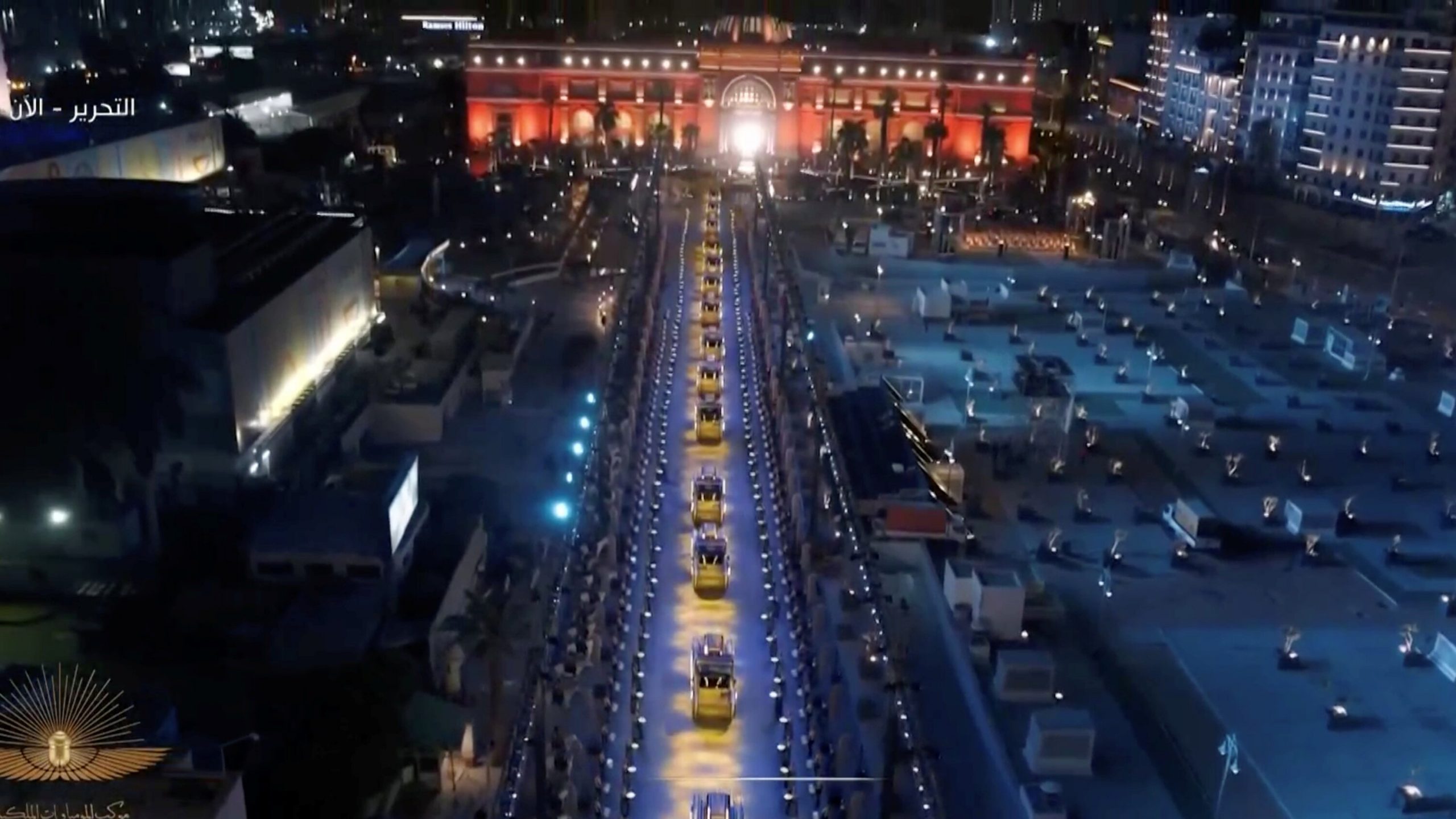
A country struggling with political, economic and medical crises, Egypt recently turned the transportation of the ancient pharaoh inheritance between two museums to a touristic parade, which became the beacon of the country’s twisted agenda. The event’s backstage drew intense reactions from various circles.
On the evening of April the 3rd, an ostentatious transfer ceremony was held, where goods were transferred by a motorized convoy from the Egyptian Museum in Tahrir Square, located Cairo, the country’s capital, to the newly opened National Museum of Egyptian Civilization, located in the Fustat region. Each one of the huge vehicles in the convoy, which were halfway between luxurious official automobiles and superhero vehicles inspired by cartoons in terms of design, carried pharaoh remnants of the ancient Egyptian civilization. The cultural heritage of 22 royal mummies, consisting of the historical relics of a total of 18 kings and four queens was transferred to the new museum, which was located five kilometres to the southwest of the country.

Local authorities of the region blocked this route along the Nile for public vehicle traffic for the duration of the event. Due to the Covid-19 global pandemic case, the country’s tourism had already been impacted from this blockage for a long while. Nevertheless, when the royal mummies reached their new resting places, President Abdel Fattah el-Sisi greeted them at the gate with 21 celebratory gun fires. Members of the UN Education, Science and Culture Organization UNESCO and the World Tourism Organization were also present at the ceremony.
Zahi Hawass, who is known in the global media with his hat similar to that of Indiana Jones, the famous adventurous archaeologist of Hollywood, told the press that those historical remains were kept in nitrogen-coated capsules to prevent damage during the transfer, in almost every statement and interview he gave about Egypt’s ancient cultural heritage.
Preparations for the official moving ceremony for 22 mummies began many days in advance. The event also seemed that it was home to an energy, which resembled the parade of movie stars at international film festivals in the past. Nevertheless, the most ironic part of this, which made the reality and dreams clash, was the cinematic treatment towards the relics of noble individuals belonging to a civilization which “believed in resurrection”, in a time and place when people live with a constant pandemic threat against their lives.

Archaeologist Hawass emphasized the reason why the mummies made their way to the museum of civilization in Fustat, using a rejuvenated reference to the “civilization”, mentioned in their presentation. According to Hawass, presenting these mummies in a most “civilized” form to the audience in an even more educational approach was far more preferential and necessary than considering them as an element of entertainment. Nevertheless, while approaching to it with great respect, this transport organization also seemed to be a little too pompous.
Yes, among these noble Egyptians discovered by excavations in the Deir el-Bahari temple and cemetery area in Luxor near the Valley of the Kings from 1871, the last king of the 17th Dynasty, Seqennere Tao, who died in a dire incident, and Ramses the Second With the 1st Set, members like Ahmose-Nefertati also arrived in their places. Therefore, in her statement to the Voice of America, American University academic Salima Ikram emphasized that what was done was a way of respect shown to them, as they were the Kings of Egypt and the Pharaohs of Egypt.
On the other hand, the huge show with horse-drawn carriages and young girls became the target of social media and activists. Because such a show of force did not seem necessary and convincing to some, in the face of administrative issues raging in the country over the pandemic recently, the tension created by the current political prisoners and the economic difficulties caused by the ongoing pressures. In one of these criticisms, the statement “If the nobility of death is at stake, then life must have rights to,” came to the fore. The owner of that statement, writer May Azzam, evaluated the current state of the country, which is under certain heat due to human rights abuse, continued “I hope one day in Egypt, those who live will be appreciated gloriously, at least, as the dead.”

Again, referring to the political prisoners of the country, which has been heavily criticized due to its military regime, journalist Jawaa Auge stated that thousands of families had difficulty accepting the joy of this “beautiful” show at a time when they were longing for their safe return of their children. El-Sisi, the current leader who overthrew Mohamed Morsi, who had came to power through an election in 2013, has kept at least 60 thousand political prisoners from their freedom so far with his decrees. And, according to journalist Abdulrahman Ayyas’ assessment, El-Sisi and his cabinet, army, and military intelligence permitted the pillage and destruction of the Egyptian Museum, when the revolutionaries were desperately trying to protect it. After all, a critical review on the subject in the New York Times was like a manifestation of the surreal distortion in the reality.
Sarah Zahir was one of those who came from the poor neighbourhoods with her three friends to watch the spectacular demonstration decorated with motorcycles, cavalry, and marching bands, where the government camouflaged the roadsides with huge flags and plastic images in order to prevent creating a mirror of the social injustice in the city. Zahir explained that when they wanted to watch this mummy convoy, in which Egyptian cinema and TV star Mona Zaki also participated, a police officer yelled at them and ordered to go home and watch the ceremony on TV.
As a result, this unprecedented relocation event has managed to become a beacon of the distortion between Egypt’s ostensible attention to the past of its lost civilization and the same country’s protective and possessive actions towards its current living society.
References:
voanews.com/africa/egyptian-mummies-paraded-through-cairo-way-new-museum
middleeasteye.net/news/egypt-celebration-mummy-ancient-dead-criticised-human-rights
nytimes.com/2021/04/03/world/middleeast/cairo-mummies-parade.html
fox2now.com/news/national/lost-city-found-22-egyptian-mummies-moved-in-royal-parade/



